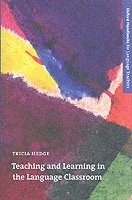
- Format
- Häftad (Paperback)
- Språk
- Engelska
- Antal sidor
- 464
- Utgivningsdatum
- 2000-01-01
- Förlag
- OUP Oxford
- Illustratör/Fotograf
- illustrations
- Illustrationer
- Ill.
- Dimensioner
- 250 x 165 x 25 mm
- Vikt
- Antal komponenter
- 1
- ISBN
- 9780194421720
- 755 g
Teaching and Learning in the Language Classroom
A guide to current ideas about the theory and practice of English language teaching
- Skickas från oss imorgon
- Fri frakt över 249 kr för privatkunder i Sverige.
Passar bra ihop
De som köpt den här boken har ofta också köpt Slow Productivity av Cal Newport (häftad).
Köp båda 2 för 769 krKundrecensioner
Innehållsförteckning
Acknowledgements; Introduction; PART ONE: A FRAMEWORK FOR TEACHING AND LEARNING; 1. Learners and learning, classrooms and contexts; 1.1 Introduction: issues for the language teacher; 1.2 What do we know about how languages are learned?; 1.2.1 The nature of input; 1.2.2 The process of intake; 1.2.3 The role of interaction in the classroom; 1.2.4 The role of error; 1.3 How do differences among learners affect learning processes and teaching procedures?; 1.3.1 Aptitude; 1.3.2 Learning style and learning strategies; 1.3.3 Affective factors; 1.3.4 Motivation for learning English; 1.4 What factors of context should teachers take into account?; 1.5 What roles can teachers and learners play in the learning process?; 1.5.1 The teacher's roles and responsibilities; 1.5.2 The learner's roles and responsibilities; 1.6 What roles can learning materials play?; 1.7 Conclusion; Discussion topics and projects; Further reading; 2. The communicative classroom; 2.1 Introduction: the concept of communicative language ability; 2.2 What are the components of communicative language ability?; 2.2.1 Linguistic competence; 2.2.2 Pragmatic competence; 2.2.3 Discourse competence; 2.2.4 Strategic competence; 2.2.5 Fluency; 2.3 What are the issues for the communicative curriculum?; 2.4 What are the implications for the communicative classroom?; 2.4.1 What are communicative tasks and what are their roles in teaching and learning?; 2.4.2 How can we manage a communicative classroom?; 2.4.3 What does communicative language teaching imply for authenticity in the classroom?; 2.5 What are the issues in applying a communicative approach in context?; 2.6 Conclusion; Discussion topics and projects; Further reading; 3. Learner autonomy and learner training; 3.1 Introduction: the self-directed learner; 3.2 What do we know about the strategies of the 'good language learner'?; 3.2.1 Types of learner strategy; 3.2.2 Research into learner strategies; 3.3 What insights can we gain from educational thinking on autonomous learning?; 3.4 What are the implications for learner training in the classroom?; 3.4.1 Activities which help learners to reflect on learning; 3.4.2 Activities which train strategies and equip learners to be active; 3.4.3 Activities which encourage learners to monitor and check their own progress; 3.5 What role can self-access facilities play in language learning?; 3.6 Are learner autonomy and learner training universally appropriate concepts?; 3.7 Conclusion; Discussion topics and projects; Further reading; PART TWO: TEACHING THE LANGUAGE SYSTEM; 4. Vocabulary; 4.1 Introduction: the task of learning vocabulary; 4.2 What do we know about the lexical system of English?; 4.2.1 Denotative and connotative meaning; 4.2.2 Meaning relations among words; 4.3 How do second language learners acquire vocabulary?; 4.3.1 Strategies for vocabulary learning; 4.3.2 Factors affecting vocabulary acquisition; 4.4 What are the implications for the teaching of vocabulary?; 4.4.1 Developing a variety of techniques for the teaching of meaning; 4.4.2 Encouraging the development of effective strategies; 4.4.3 Exposing learners to vocabulary through reading and training lexical inferencing; 4.4.4 Teaching the effective use of dictionaries; 4.4.5 Evaluating the vocabulary component of coursebooks; 4.4.6 Teaching vocabulary explicitly through a range of activity types; 4.4.7 Developing resources for vocabulary teaching; 4.5 Conclusion; Discussion topics and projects; Further reading; 5. Grammar; 5.1 Introduction: the role of grammar in English language teaching; 5.2 What do we know about the learning of grammar?; 5.2.1 Noticing; 5.2.2 Reasoning and hypothesizing; 5.2.3 Structuring and restructuring; 5.2.4 Automatizing; 5.3 What information can help us in the selection and presentation of grammar?; 5.3.1 Grammar as meaning; 5.3.2 Grammar in discourse; 5.3.3 Grammar and style; 5.4 What principles can guide us in the teach


